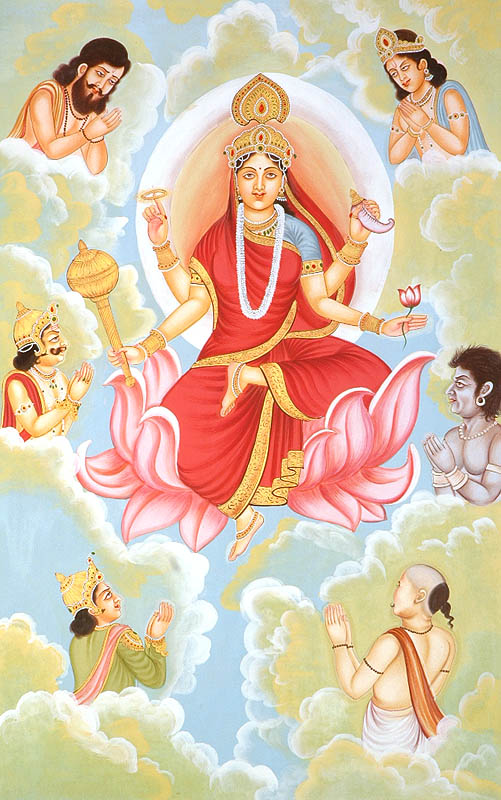
by Somya Devi | Oct 21, 2015 | Astrology, Holy Days
The ninth day of Navaratri is of utmost importance, and is marked by shukla navami, the ninth tithi (lunar phase) of the waxing Moon this month. On this day we honor Goddess as Siddhidatri, the giver of all siddhis, special powers or perfect attainments. Siddhis are magical, spiritual, or psychic powers, attained through dedication and devoted practice. Through worship and meditation upon all the forms of Durga, culminating with that of Siddhidatri, we can attain perfection and infinite blessings from her. Through the siddhis, all desires can be fulfilled. It is often said that the greatest blessing one can receive is to transcend all desires, or to have one’s only desire be to know Goddess/God.
With the blessing of devotion, through her grace, we can remain peaceful and happy in all circumstances, blissfully experiencing the Divine Mother’s presence in and throughout all of creation, in every moment. In this way the ninth day of Navaratri also relates to the illuminating wisdom of Sarasvati, who is often worshiped over the last three days of this festival.
In her depiction, Siddhidatri sits on a lotus or a lion and holds a discus (representative of the chakras), a lotus, a mace, and conch shell, which she will use to sound the victory we attain through her worship. She is surrounded by and worshiped by all forms of divine beings–Gods, demons, spiritual masters and nature-spirits. It is said that even Lord Shiva received his powers from Siddhidatri. In the divine form that is half Shiva and half Shakti, he is merged with Siddhidatri and known as Ardhanarishvara.
Siddhidatri relates to Ketu (the south node of the Moon), and thus she governs our deep and ancient psychic wisdom. She is a powerful goddess to worship for enhancing spiritual, psychic and energetic healing powers.
Full Article on Navaratri 2017
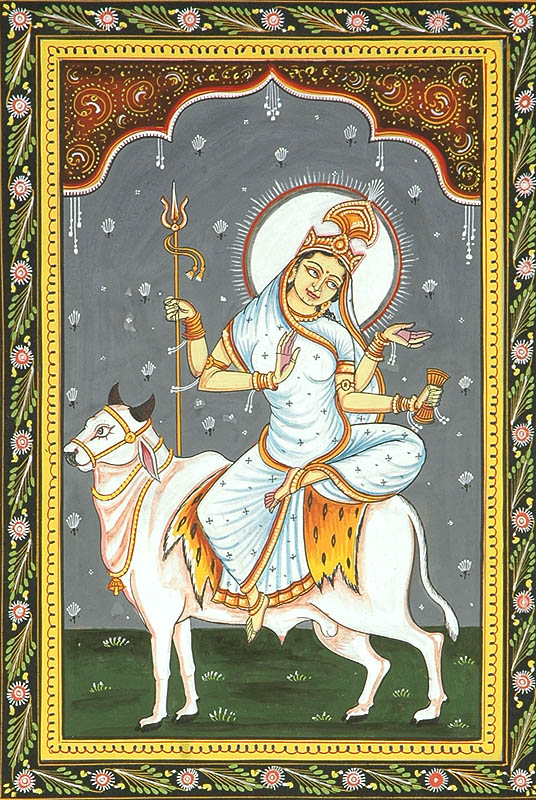
by Somya Devi | Oct 20, 2015 | Astrology, Holy Days
Shukla ashtami, the eighth tithi (lunar phase) of the waxing Moon this month, marks the eighth day of Navaratri during which we honor Goddess as Mahagauri, the “great white” goddess. This incarnation of Durga is fair, shining and radiant like pure light, representing her purifying shakti. She rides a bull and carries a damaru (a hand-drum) and a trisul in two hands, keeping the other two in mudras for blessing and protecting. She represents compassion, truth, and purity and bestows these on her devotees. Mahagauri is often thought of as the young form of Parvati, and thus worshipers often feed young girls sweets on this day of celebration, to honor the great white goddess.
The story is often told that while Parvati was doing penance to win Lord Shiva, her body became black and dirty. When Shiva accepted her he washed her with the water of the Ganga which made her shine resplendently and become Mahagauri. This represents her power to free us from all pain and suffering and to bless us with auspiciousness and virtues, as those who bathe in the waters of the holy river Ganga are said to be blessed and purified. This includes freeing us from the painful attachments to the material world. As we worship Mahagauri after the night of worship dedicated to Kalaratri, we can see that this detachment and reemergence into the light can come only after facing death and darkness.
This goddess relates to the planetary deity Rahu (the north node of the Moon), who is actually a shadow point in the cosmos and has no physical body. Thus Mahagauri relates to parts of our soul and psyche that are beyond the physical body or chakra system. In our worship, making offerings to her and meditating upon her, we can begin to go beyond our attachments to the mundane details of life and brighten our awareness of spirit.
Full Article for Navaratri 2017
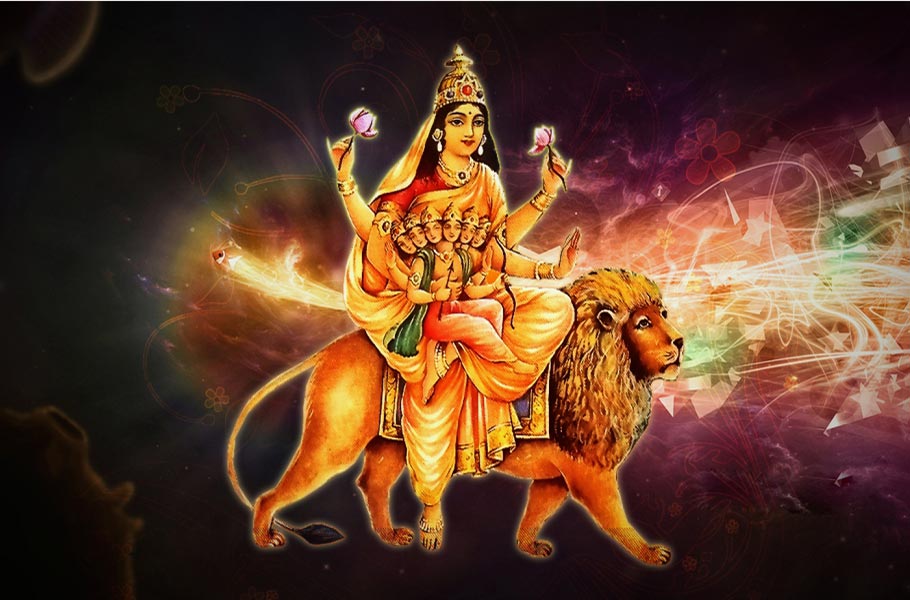
by Somya Devi | Oct 17, 2015 | Astrology, Holy Days
Shukla panchami, the fifth tithi (lunar phase) of the waxing Moon this month, marks the fifth day of Navaratri wherein we celebrate Goddess in the form of Skandamata (literally the “mother of Skanda”). Skanda is a name for Kartikeya (also known as Murugun and Subramanya), the brother of Ganesha (both sons of Shiva and Parvati). We see Skandamata depicted holding her young six-headed son, as well as holding lotus flowers and keeping one hand in a blessing mudra. In worshiping her we call forth the protection and care that the Divine Mother has for all of creation, as all are her children. She blesses us with bliss, happiness, and motherly love, as well as nourishment and good health.
Kartikeya is the Lord of War, the leader of the army of devas (Gods) who fight the asuras (demons) in Hindu mythology. In the stories, the demon Tarakasura was tormenting all of humanity, and it was destined that only Lord Shiva’s son would be able to kill him and save the world. Shiva had renounced everything and was lost in meditation, however, after the death of his first wife, Sati. The Gods devised a plan and ensured that Parvati was born (a reincarnation of Sati), and followed a path that would result in Shiva’s emerging from meditation and remarrying. When they finally married, Shiva and Parvati ended up making love for millions of years while the world awaited their savior. Eventually, the fire deity, Agni, snuck into their cave in order to steal the seed that was needed. It was so hot that he could not hold it, however, and dropped it in the river Ganga (another manifestation of Goddess), who deposited the infant Skanda on her banks where he was found and nourished by six women (thus the six heads).
The demons represent the ignorance which gives rise to all human impurities and misfortune. In worshiping Skandamata we also worship Skanda and receive his blessings, including protection from harm and victory over our enemies, both internal and external. Skandamata relates to the vishuddhi (throat chakra), meaning “pure” or “undiluted,” showing that we can attain purity and realize infinite blessings through her worship. She is rules the planet Mercury (Budha), the planet and deity of communication and the intellect.
Full Article on Navaratri 2017
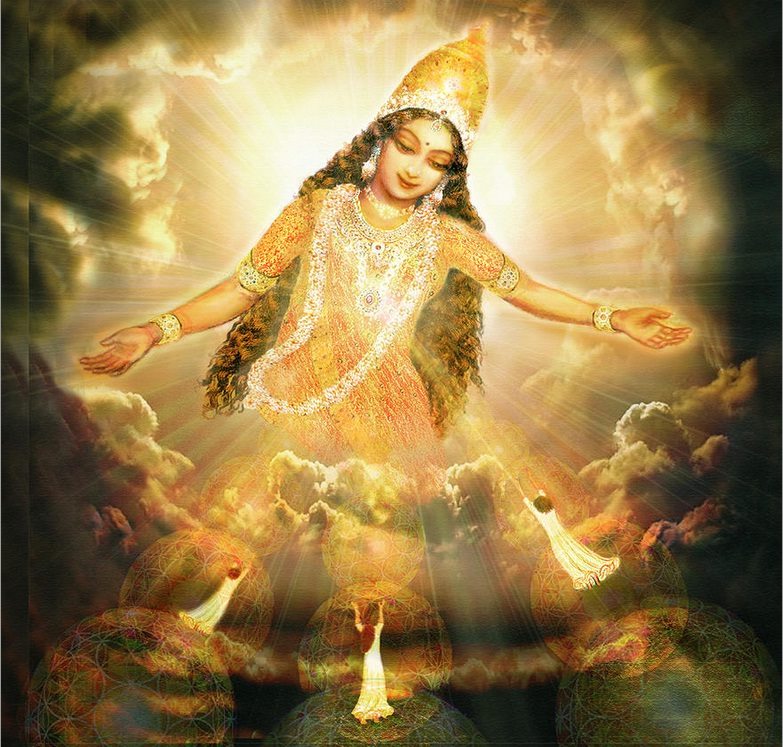
by Somya Devi | Oct 10, 2015 | Astrology, Conjunctions, Events, Holy Days
New Moon in Virgo in Chitra Nakshatra and Navaratri
As we complete the most recent lunar cycle which brought two powerful eclipses, we are settling into the effects and transformation that they brought to our lives. The solar and lunar eclipses of September were the last of a series to occur with the nodes in sidereal Virgo and Pisces, where they have sat since July 2014. Lessons that we have been working on through this time have taken on a new light, and many of us are now ready to face change and growth, whether it be in career, relationships, residence, or other important areas of life that have recently transformed.
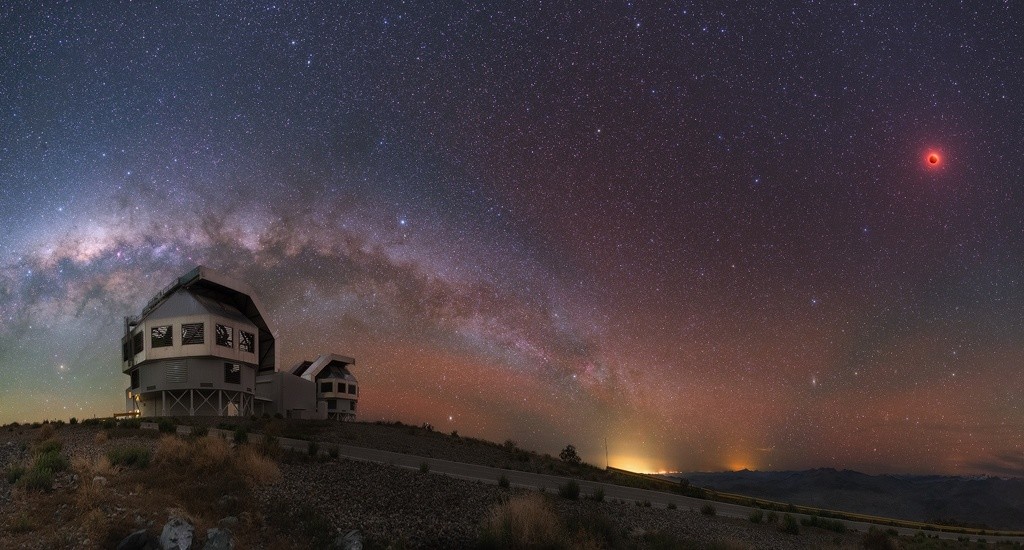 The New Moon in Virgo in Chitra nakshatra occurs on October 12th and offers us a day (and night) of stillness and darkness to sit with the changes, go inward and reflect, and prepare for the next lunar cycle. This Dark Moon phase will be from around 3pm PDT on October 11th until 5:05 pm on October 12th, at which time the Moon and Sun will be at a conjunct longitude (commonly called the New Moon). This conjunction happens near the end of Virgo constellation, in the Vedic nakshatra called Chitra. After that point the Moon begins its waxing phase, and the new lunar month.
The New Moon in Virgo in Chitra nakshatra occurs on October 12th and offers us a day (and night) of stillness and darkness to sit with the changes, go inward and reflect, and prepare for the next lunar cycle. This Dark Moon phase will be from around 3pm PDT on October 11th until 5:05 pm on October 12th, at which time the Moon and Sun will be at a conjunct longitude (commonly called the New Moon). This conjunction happens near the end of Virgo constellation, in the Vedic nakshatra called Chitra. After that point the Moon begins its waxing phase, and the new lunar month.
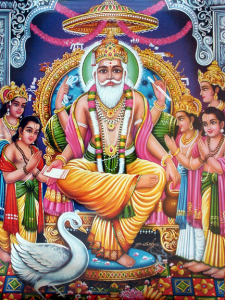 Chitra means “the brilliant” and is a very creative place in the zodiac. The deity for Chitra is Vishvakarma, the divine architect of the cosmos. This month we will feel inspired to create and to perfect our creations, just as the architect creates the universe in perfection. We will be attracted to investigate the mystery behind that divine creation. Gemstone medicine is powerful now, as gems are a symbol of this star. Chitra also relates to magic, and it is a time to tap into the powerful forces of magic within ourselves, and let them shine brightly.
Chitra means “the brilliant” and is a very creative place in the zodiac. The deity for Chitra is Vishvakarma, the divine architect of the cosmos. This month we will feel inspired to create and to perfect our creations, just as the architect creates the universe in perfection. We will be attracted to investigate the mystery behind that divine creation. Gemstone medicine is powerful now, as gems are a symbol of this star. Chitra also relates to magic, and it is a time to tap into the powerful forces of magic within ourselves, and let them shine brightly.
Beginning this cycle in Virgo, and with Sun and Moon joined with exalted Mercury there, we feel Mercury’s influence compelling us to seek understanding, and to organize the details around our creative pursuits. The second half of Chitra falls in Libra (as will the Sun during much of this lunar cycle), and under Venus’s influence, we may also feel called to balance our relationships this month. Mars is the nakshatra ruler for this star, and he brings us an energy, along with the fire element, that helps fuel along our creativity. There may be more emphasis on sexuality this cycle. Chitra is itself a balancing point in the zodiac, being the middle (14th) of the 27 nakshatras, so we seek harmony in all things as we prepare for the next season.
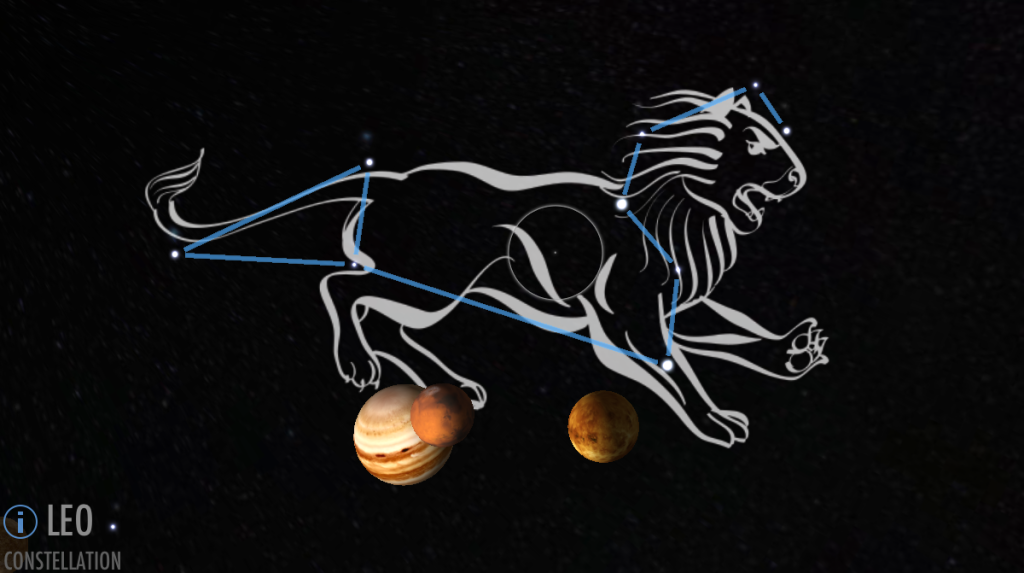 For most of this cycle (through November 2nd), we also experience the influence of Jupiter, Venus, and Mars all joined in Leo. This will make us give a lot of importance to the things all three of these planets represent (beliefs, desires, and personal will). At times this could create conflict (especially when they pass over each other in close conjunction), but in general it gives us a lot of energy. Jupiter in Leo energizes our belief systems, giving our philosophies a lot of weight in our decision-making process. Venus in Leo makes our desires come to the forefront, and we must be careful not to be too indulgent or selfish when it comes to getting what we want (whether it be in relationships or in our pursuit of beauty and recreation). Mars in Leo adds extra fire to the planet of action, will and energy, which could be good for our personal physical discipline, but could also cause us to get aggravated and argumentative over our philosophies and desires. Turn that Martian energy on yourself instead of getting hot-headed with others (read: time to reboot your workout routine or asana practice!). Sun’s rulership of Leo gives us the opportunity to work on purifying and refining all of these things this month–our beliefs, our desires, and our instinctual energy driver.
For most of this cycle (through November 2nd), we also experience the influence of Jupiter, Venus, and Mars all joined in Leo. This will make us give a lot of importance to the things all three of these planets represent (beliefs, desires, and personal will). At times this could create conflict (especially when they pass over each other in close conjunction), but in general it gives us a lot of energy. Jupiter in Leo energizes our belief systems, giving our philosophies a lot of weight in our decision-making process. Venus in Leo makes our desires come to the forefront, and we must be careful not to be too indulgent or selfish when it comes to getting what we want (whether it be in relationships or in our pursuit of beauty and recreation). Mars in Leo adds extra fire to the planet of action, will and energy, which could be good for our personal physical discipline, but could also cause us to get aggravated and argumentative over our philosophies and desires. Turn that Martian energy on yourself instead of getting hot-headed with others (read: time to reboot your workout routine or asana practice!). Sun’s rulership of Leo gives us the opportunity to work on purifying and refining all of these things this month–our beliefs, our desires, and our instinctual energy driver.
 During the first nine days and nights of the waxing Moon this month, Navaratri is celebrated (starting October 13th in North America). Literally the “nine nights,” this is a Hindu festival dedicated to worshiping the Goddess, Devi, in her many forms, for nine days and nights. As the night represents darkness and ignorance, we pray to her to help reveal and remove our shortcomings, bestow blessings, and confer wealth and knowledge. We face the darkness and call on the Divine Mother to remove it and let the Atma, or the pure divinity within each of us, shine forth. Navaratri worship can include creating a special altar to the Goddess, and making daily offerings including flowers, food, incense, light (a flame), ghee, as well as prayer, fasting, meditation, mantras and bhajans (devotional songs). The Devi Mahatmya (a.k.a. Chandi Path), the story of Durga, is a traditional text to read throughout this festival. In some places Devi is worshipped over the nine nights in reverence to nine incarnations of Durga: Shailputri, Brahmacharini, Chandraghanta, Kushmanda, Skandamata, Katyayani, Kalaratri, Mahagauri and Siddhidatri. Occurring in the fall-time in India and the northern hemisphere, this Navaratri also coincides with the harvest season, and is a great time to give thanks for the abundance of the harvest and pray that it carries us through the winter season.
During the first nine days and nights of the waxing Moon this month, Navaratri is celebrated (starting October 13th in North America). Literally the “nine nights,” this is a Hindu festival dedicated to worshiping the Goddess, Devi, in her many forms, for nine days and nights. As the night represents darkness and ignorance, we pray to her to help reveal and remove our shortcomings, bestow blessings, and confer wealth and knowledge. We face the darkness and call on the Divine Mother to remove it and let the Atma, or the pure divinity within each of us, shine forth. Navaratri worship can include creating a special altar to the Goddess, and making daily offerings including flowers, food, incense, light (a flame), ghee, as well as prayer, fasting, meditation, mantras and bhajans (devotional songs). The Devi Mahatmya (a.k.a. Chandi Path), the story of Durga, is a traditional text to read throughout this festival. In some places Devi is worshipped over the nine nights in reverence to nine incarnations of Durga: Shailputri, Brahmacharini, Chandraghanta, Kushmanda, Skandamata, Katyayani, Kalaratri, Mahagauri and Siddhidatri. Occurring in the fall-time in India and the northern hemisphere, this Navaratri also coincides with the harvest season, and is a great time to give thanks for the abundance of the harvest and pray that it carries us through the winter season.
In some places, the first three nights of Navaratri are dedicated to Goddess in the form of Durga or Kali, who help us to destroy and remove negative tendencies in our minds and hearts, cleansing them of impurities that create obstructions in our spiritual and material pursuits. The next three nights are dedicated to Goddess in the form of Lakshmi, who helps us to cultivate positive qualities, like compassion and devotion. She helps us to achieve spiritual and material prosperity. In the final three nights we worship Goddess as Sarasvati, who assists us with learning and attaining knowledge and wisdom, through the illumination of consciousness. She relates to prana, the vital breath, often associated with chi or life-force. Through our devotion, service, practice, study, and meditation (all forms of yoga), we allow prana to flow freely, helping us to exist in a state of peace, bliss, and oneness. The tenth day of Navaratri is known as Vijayadashami, the day of victory. After calling upon the Divine Mother’s presence and qualities to arise from within us for nine days and nights, we emerge victorious, basking in Her light and virtues. This will be an auspicious time (October 22nd) for beginning new ventures, especially creative and spiritual pursuits.
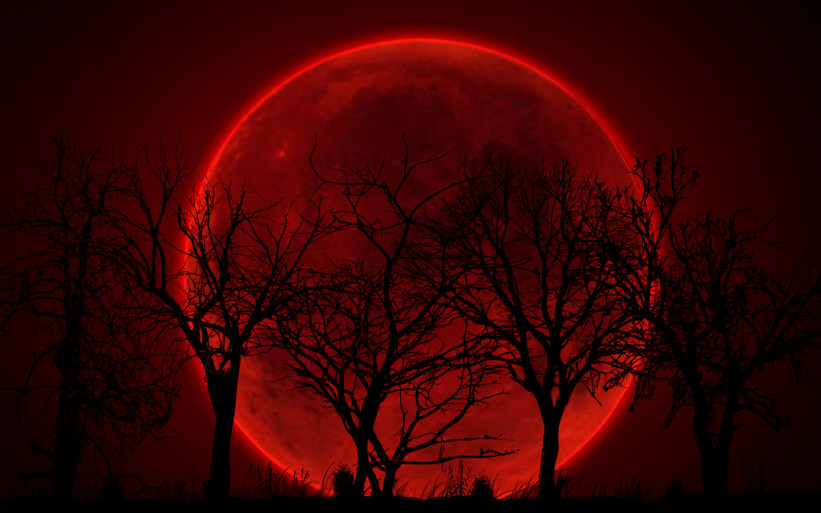
by Somya Devi | Sep 25, 2015 | Astrology, Eclipses, Events
The Full Moon and Lunar Eclipse in Uttara Bhadrapada will coincide in sidereal Pisces on the night of Sunday, September 27th, with the peak of the eclipse around 7:47 pm PDT (and the peak of the full Moon at 7:50). This is the final eclipse in a series of eclipses since Rahu and Ketu, the north and south nodes of the Moon, have been in sidereal Virgo and Pisces for the last year. During these eclipses we have been unearthing the shadows of our subconscious drives towards the moods represented by these two signs. The mood of Virgo compels us to organize the details of life and our material surroundings, to perform hard work responsibly in order to avoid conflict, and to iron out imperfections in ourselves and others. Pisces, on the opposite side of the zodiac, draws us to let go of the material world and surrender into the unknown, embracing imagination and life’s mysteries, or sometimes escaping into fantasy or other outlets to avoid the drudgery of life.
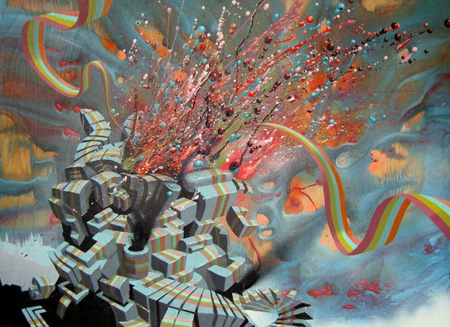
The eclipses around this astronomical axis have drawn our attention to these opposite compulsions. As the “shadow planets” align with the Sun (our inherent divine power) and the Moon (our emotional bodies), we may see what is normally subconscious but drives us to one or both of these extremes. There could arise distress around our desire to keep everything materially organized, or our tendency to be overly responsible and meticulous. This is put in glaring contrast for us when we see Pisces’ need for us to surrender to the flow and be more fluid in life’s waters. On the other hand, one’s shadow tendency to escape and avoid may arise, often in chaotic and confusing ways, to show us that we better need to integrate our dreamy idealism with practical management of life’s details. The period surrounding the eclipses can often feel turbulent, stressful, and confusing, but there are always deeper lessons being offered so that we can learn truer ways to bring forth the empowerment of our spirit and the comforting of our hearts.
This full Moon is a Supermoon–one that occurs with the Moon at it’s closest orbital point to earth (perigree). The Moon will look up to 14% larger than usual! During a lunar eclipse, the Moon takes on a dim red coloring, and is often referred to as a “blood moon” because of this. Why doesn’t the moon totally disappear behind the earth’s shadow? During solar eclipses, the Moon’s orb (directly between Earth and the Sun) appears as a black disc that almost completely covers the Sun’s light for a few minutes, save for a thin bright ring around the outside of the disc (in a total solar eclipse). The light we see as moonlight, however, is actually the light of the Sun being reflected off of the Moon. The Sun’s rays pass through the atmosphere of Earth before reaching the Moon, and are refracted in many directions. This is why the Moon does not completely disappear during the lunar eclipse — sunlight is still reaching it, but through indirect, scattered rays bouncing through the atmosphere and around the earth.
This phenomenon corresponds to the astrological idea that eclipses often cause confusion and may make us feel scattered. Furthermore, it can be hard to get in touch with the emotions of the heart (Moon energy) during a lunar eclipse, as the divine light of the Sun is reaching the emotional body only through shadowy twists and turns, not directly or with its full potency. As such, a lunar eclipse can feel especially heavy on the heart, and we may feel all twisted up inside. At the same time, we can see and feel the twisty things that are normally dormant, hidden or overlooked, but nevertheless are molecular paths making up part of our inherent experience. This is a good time to face the things that are unpleasant, or that cause us confusion or heartache, so we can let go and realign. We can look at where we have been sidestepping our way to emotional nourishment (especially through avoidance) instead of taking action by the most direct routes of self-care. Applying conscious effort and prayer, we can let go of unsupportive patterns and make way for the most authentic ways of nourishing our hearts and minds.
 The fullest part of the Total Lunar Eclipse will be from 7:11pm – 8:23 pm PDT. The beginnings and ends of the eclipse will be visible from 5:11pm to 10:22pm. Within the region of Pisces, Vedic Astrology further divides the sky, and we see that this eclipse is in the nakshatra of Uttara Bhadrapada. This star-sign lies in the area of Pegasus and Andromeda, directly above the constellation of Pisces. The deity of this nakshatra is Ahirbudhnya, the serpent from the depths, and thus this constellation relates to kundalini as well as deep emotional waters. Much wisdom is available here. As we feel into the depths of the emotions, Saturn’s rulership of this sign makes us face our fears, and strengthen our connection to divine consciousness as we loosen our attachment to the material.
The fullest part of the Total Lunar Eclipse will be from 7:11pm – 8:23 pm PDT. The beginnings and ends of the eclipse will be visible from 5:11pm to 10:22pm. Within the region of Pisces, Vedic Astrology further divides the sky, and we see that this eclipse is in the nakshatra of Uttara Bhadrapada. This star-sign lies in the area of Pegasus and Andromeda, directly above the constellation of Pisces. The deity of this nakshatra is Ahirbudhnya, the serpent from the depths, and thus this constellation relates to kundalini as well as deep emotional waters. Much wisdom is available here. As we feel into the depths of the emotions, Saturn’s rulership of this sign makes us face our fears, and strengthen our connection to divine consciousness as we loosen our attachment to the material.
 Uttara Bhadrapada also relates to the funeral cot and the process of death and dying. With the Moon eclipsed here, we may feel like we are dying, or may desire to retreat and escape from the world temporarily. We may need to allow the death of something whose time has come, our attachment to which has been holding us back from living in our highest alignment with spirit. Also a Harvest Moon (the full Moon closest to the fall equinox, accompanied by many nights of bright moonlight in the evening), it is time to cut down and allow the death of what we have been cultivating, and permit it to transform into its next purpose. This may involve letting go of some of our desire to organize the material world (the mood of Virgo, where the Sun lies). The approach of this eclipse has likely brought up a lot of conflict and confusion around this issue, and the Solar eclipse on September 12th likely disturbed the other end of the spectrum (material stability). We may also be called to find more balance in our Virgoan pursuits, and be more meticulous with our own spiritual practices rather than with everything and everyone in the world around us.
Uttara Bhadrapada also relates to the funeral cot and the process of death and dying. With the Moon eclipsed here, we may feel like we are dying, or may desire to retreat and escape from the world temporarily. We may need to allow the death of something whose time has come, our attachment to which has been holding us back from living in our highest alignment with spirit. Also a Harvest Moon (the full Moon closest to the fall equinox, accompanied by many nights of bright moonlight in the evening), it is time to cut down and allow the death of what we have been cultivating, and permit it to transform into its next purpose. This may involve letting go of some of our desire to organize the material world (the mood of Virgo, where the Sun lies). The approach of this eclipse has likely brought up a lot of conflict and confusion around this issue, and the Solar eclipse on September 12th likely disturbed the other end of the spectrum (material stability). We may also be called to find more balance in our Virgoan pursuits, and be more meticulous with our own spiritual practices rather than with everything and everyone in the world around us.
 The shakti of Uttara Bhadrapada is the power to bring rain. Call upon the cleansing energy of rain to help wash away the old and stale and nourish the soil of decay to make it fertile for new life. Pisces is the last sign of the zodiac and brings us closer to death, helping us to see that the material clinging we experience through life is not what is eternal. As we release our holding and consciously embrace the unknown–rather than simply falling into the escapist potential of Pisces energy–we come in contact with the abundance of divinity that lies within the great mystery. We can awaken the serpent power of Ahirbudhnya and invite new wisdom to circulate through our free-flowing channels. The Full Moon and Lunar Eclipse in Uttara Bhadrapada on September 27th offer us the chance to see into our own depths and expand our capacity for conscious surrender as we continue into the next chapter.
The shakti of Uttara Bhadrapada is the power to bring rain. Call upon the cleansing energy of rain to help wash away the old and stale and nourish the soil of decay to make it fertile for new life. Pisces is the last sign of the zodiac and brings us closer to death, helping us to see that the material clinging we experience through life is not what is eternal. As we release our holding and consciously embrace the unknown–rather than simply falling into the escapist potential of Pisces energy–we come in contact with the abundance of divinity that lies within the great mystery. We can awaken the serpent power of Ahirbudhnya and invite new wisdom to circulate through our free-flowing channels. The Full Moon and Lunar Eclipse in Uttara Bhadrapada on September 27th offer us the chance to see into our own depths and expand our capacity for conscious surrender as we continue into the next chapter.













